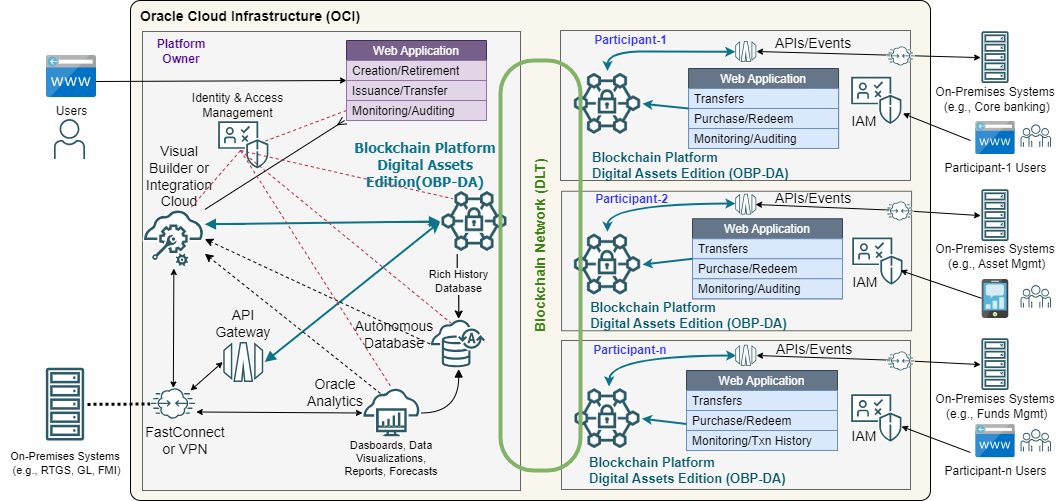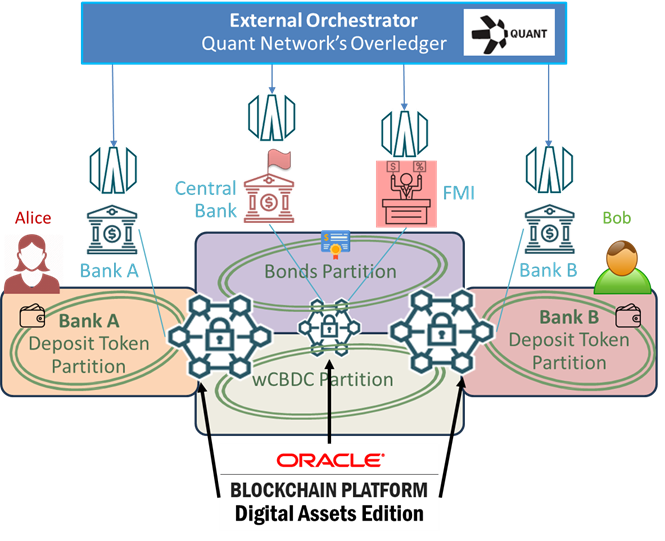Introduction
The digital economy is going through a major transformation, enabled by tokenization which propelled the rise of digital assets in the regulated finance, including central bank digital currencies (CBDC), deposit tokens and stablecoins, and tokenized securities like stocks and bonds, as well as Real-World Assets (RWAs), such as real estate, land records, collectibles, luxury goods, and other tokenization concepts that enhance efficiency and collaboration across diverse ecosystems and enable innovative services.
To date most of these initiatives rely on siloed ledgers that limit the portability of digital assets. Recently Bank for International Settlements (BIS) and other leading voices in the global financial system have begun discussing Finternet and unified ledgers – a new type of financial market infrastructure that could capture the full benefits of tokenisation by combining central bank money, tokenised deposits, and tokenised assets on a programmable platform.
Announcement
Oracle has launched Oracle Blockchain Platform Digital Assets Edition (OBP DA) – a powerful enterprise-grade solution designed to streamline the development and deployment of digital assets applications and build unified ledgers. This platform simplifies and accelerates tokenization efforts by combining a comprehensive bank-grade distributed ledger infrastructure with pre-packaged smart contracts, APIs, powerful indexing database capabilities, web applications, and analytics tools, enabling organizations to bring innovative digital asset solutions to the market faster.
OBP DA is an extension of industry-leading Oracle Blockchain Platform, which has been recognized as the leader in Juniper Research Competitor Leaderboard of blockchain platforms and also recognized by Government Blockchain Association (GBA) for passing Blockchain Maturity Model (BMM) Assessment. It can be provisioned in Oracle Cloud Infrastructure (OCI) as a managed service and extended with Kubernetes container-based nodes deployed on-premises or in other clouds.
Why Use Oracle Blockchain Platform Digital Assets Edition?
The digital asset landscape is rapidly evolving. Many organizations struggle with the high costs, complexity, and expertise required to develop secure and scalable blockchain-based financial solutions. OBP DA addresses these challenges by providing:
- Instant domain expertise: Comprehensive pre-packaged application components provide instant access to specialized domain capabilities, enabling businesses to enter the market faster.
- Lower development costs: Pre-built tokenization frameworks and application-specific smart contracts coupled with production-ready blockchain platform and low-code development tooling reduce the need for highly expensive staff and long development cycles.
- Faster innovation cycles: Auto-generation of smart contracts and APIs based on tailorable specification templates accelerate deployment timelines and speed up innovation, while low-code smart contract, web application, and analytics tools provide flexibility for customization.
- Seamless interoperability: Cross-ledger asset portability supports the vision of unified financial systems with real-time settlement using atomic transactions and powerful orchestration capabilities.
- Enterprise-grade security: Compliance with global security and regulatory standards ensures a robust and secure platform based on permissioned Blockchain-as-a-Service, immutable audit trails, and comprehensive Oracle Cloud Infrastructure security.
- Real-time insights: Integrated analytics enable better financial decision-making and transparency using built-in indexing and pre-built dashboards and data visualizations, which are easily extensible using low-code analytics tooling.
Example Use Cases
1. Central Bank Digital Currencies (CBDCs)
Wholesale CBDCs play a crucial role in modernizing interbank payments, settlements, and financial policy implementation. OBP DA enables financial institutions and central banks to:
- Develop and deploy wholesale CBDCs with pre-packaged Hyperledger Fabric smart contract for token creation, issuance, transfer, redemption, and retirement, with optional maker-checker preventative controls.
- Implement role-based governance, supporting central bank-controlled account management minting, distribution, retirement, and compliance, with delegation of financial institution account management.
- Enhance interbank settlements with tokenized intra-bank and inter-bank transfers, optionally utilizing maker-checker approval mechanisms.
- Integrate with existing banking infrastructure using CBDC-specific APIs, Web app, and Analytics dashboards.
2. Tokenization of Financial Instruments
Tokenization is transforming banking services and capital markets by enabling faster, more secure, and cost-efficient transactions for various asset classes:
- Deposit Tokens & Stablecoins: Commercial banks can use OBP DA to issue commercial money in the form of digital deposit tokens or bank-based stablecoins for secure, real-time payments for settlement of domestic and cross-border transactions with optional compliance controls, such as daily limits and maker-checker approvals.
- Tokenized Bonds: OBP DA supports primary bond marketplaces, enabling automated issuance, purchase, interest payments, and redemption of digital bonds, with Delivery vs. Payment (DvP) settlement utilizing wholesale CBDC, deposit tokens, or bank-issued stablecoins.
3. Real-World Assets and Native Digital Assets
Tokenized real-world assets (RWAs) are digital twins of physical assets represented on blockchain. Native digital assets are tokenized representation of assets that exist only in electronic form – e.g., loyalty points, music, records of intellectual property. In both cases, tokenized representation on a blockchain provides verifiable provenance and auditability of any exchanges or updates, and unlocks numerous benefits, e.g.,:
- Tokenized real estate to allow fractional ownership and trading, enabling greater liquidity and accessibility, efficiency in purchase transactions and lending processes.
- Tokenized land records, collectibles, luxury goods, intellectual property and licenses to enable traceability of ownership, trading, and use as collateral in lending.
- Tokenized Solar Renewable Energy Certificates (SRECs) and related CO2 offsets based on use of blockchain for traceability of solar power generation, providing end-to-end traceability from the certificates to the actual generation site and records.
Components & Functionality Overview
The Oracle Blockchain Platform Digital Assets Edition (OBP DA) is designed to help organizations develop and deploy end-to-end digital asset applications quickly. The OBP DA platform extends Oracle Blockchain Platform-as-a-Service and Blockchain App Builder with a number of enhancements and includes pre-packaged domain specific or framework based smart contracts, pre-packaged wrapper APIs, indexing database views, sample Web application, and sample analytics dashboards and reports.
After navigating to Developer Services > Oracle Blockchain Platform in OCI and provisioning Digital Assets edition instance, users can navigate to Digital Assets tab on the console to install the sample chaincode and access the downloadable artifacts, which can be deployed as shown in the reference architecture diagram and explained below.

1. Oracle Blockchain Platform: Decentralized, permissioned blockchain network providing distributed ledger and smart contract platform
- Based on Hyperledger Fabric with numerous Oracle enhancements for performance, scalability, manageability, security, integration, and operations
- Delivered as Blockchain-as-a-Service in OCI and Kubernetes container-based for on-premises and multicloud deployments
- Can be used for both rapid experimentation and highly available, scalable and secured production grade applications
- Rated top blockchain platform in Juniper Research report
- Recognized by Government Blockchain Association (GBA) for passing Blockchain Maturity Model (BMM) Assessment.
2. Enhanced Blockchain App Builder: Low-code tool for auto-generating smart contracts and related artifacts from tailorable declarative specification templates, automating their testing, and managing their deployment to quickly create and optimize digital asset applications.
- Provides numerous pre-defined templates for generating common digital asset applications, including complete chaincode applications for wholesale CBDCs, bond marketplaces, real estate tokenization, loyalty tokens, collectibles, and many others
- Enables chaincodes to emit lifecycle events to help automate workflows based on token creation, transfers, and other operations, triggering external updates in real-time
- Automatically generates application-specific APIs and API routes deployment packages for OCI API Gateway, streamlining blockchain interactions while enhancing security and access control
- Automatically generates Postman collections for quick and easy testing of the generated APIs
3. Pre-packaged smart contracts for digital asset applications and frameworks: Provides application domain-specific smart contract chaincodes for wholesale CBDCs, tokenized bonds as well as generic fungible, non-fungible, and combined token frameworks.
- Pre-packaged smart contract implementation of wholesale CBDC, including full range of lifecycle operations, account management with role-based access control, approval mechanisms aligned with maker-checker practices, compliance controls, and auditing
- Pre-packaged smart contract implementation of primary bond marketplaces, including full range of lifecycle operations, account management with role-based access control, interest calculations, and redemption at maturity integrated with atomic Delivery vs Payment (DvP) settlement model for purchase and redemption
- Fungible token chaincode to enable banks and other institutions to build digital asset applications, such as deposit tokens, stablecoins, loyalty systems, and other financial instruments
- Whole and fractional NFT chaincodes for applications in digital securities, real estate, luxury goods, gaming, intellectual property management, SREC and CO2 offset certificates, and supply chain tracking
4. Rich API Support: Speeds up and streamlines enterprise integration of digital assets, reducing complexity and improving interoperability and automation
- Exposes CBDC and Bond operations as well as fungible and non-fungible token frameworks with rich set of APIs for integration with electronic channels, core banking, Real-Time Gross Settlement (RTGS) systems, other inter-bank payment systems, financial market infrastructures for trading and other operations
- Includes auto-generated tools for provisioning API Gateway resources in OCI and deploying the relevant API routes with automatic connection to relevant blockchain smart contract methods
- Includes tooling for automatic re-generation of the APIs when extending existing or creating new chaincode ensuring consistency with chaincode deployments
5. Application-specific indexing DB views: Indexing database synchronized from ledger transaction history for real-time and post-settlement analytics, and off-chain data integration with any relevant non-blockchain data
- Database views map wholesale CBDC rich history data model from JSON to columns for use by the pre-packaged analytics dashboards and data visualizations
- Enables fraud analysis with in-database Oracle Machine Learning (OML)
- Enables AML analysis with Graph database processing to explore connections and relationships across accounts and fund movements
- Can be exposed for use by other applications via Oracle REST Data Services
6. Sample Web UI application for CBDC use cases: A ready-to-use sample Web app with role-based UX flow to administer and run wholesale CBDC lifecycle operations allows for quick experimentation with digital currency application and facilitates rapid tailoring and adaptation using low-code OCI Visual Builder / Integration cloud service.
- Supports CBDC creation, issuance, redemption, and retirement as well as intra-bank and inter-bank transfers with maker-checker approval
- Maps wholesale CBDC lifecycle functions across various central bank and participating institution roles, including admins, officers, managers (approvers), auditors, and regular users
- Handles on-boarding and account management, integrated with OCI user provisioning and Hyperledger Fabric custom enrollments, compliance controls through enforcement of daily limits, and delegation of user management to each bank’s administrator role
- Extensive security with role-based access administered through Oracle IAM Identity Domains, OCI Multi-Factor Authentication, and Web Application Firewall that aggregates multi-source threat intelligence and includes more than 250 predefined OWASP, application, and compliance-specific rules
7. Sample Analytics package for CBDC use cases: Delivers real-time insights into the wholesale CBDC lifecycle operations, inter-bank transfers, and money flows enhancing transparency and decision-making for central banks and financial institutions. Facilitates quick experimentation with digital currency and rapid tailoring and adaptation with Oracle Analytics
- Leverages live blockchain data replicated to rich history DB via configurable connection
- Provides two sets of data visualizations (DVs): a complete set for the central bank and a subset with filtered data suitable for the participating institutions, who will only be able to access data relevant to their accounts and transactions
- Built in Oracle Analytics Cloud (OAC) enabling provided dashboards and visualizations to be modified and extended using OAC low-code developer mode
- Empowers users with built-in AI/ML supporting natural language interactions and anomaly detection to accelerate productivity and power better business decisions
8. Cross-ledger interoperability and unified ledger architecture: Combining Oracle Blockchain Platform support of X/Open XA standard with 2 phase commit (2PC) and powerful orchestration provided by Quant Network’s Overledger enables cross-ledger operations and workflows required to implement a unified ledger architecture, helping to overcome blockchain fragmentation and preserve “singleness of money.”
- Atomic settlement and immediate finality across multiple ledgers and off-chain databases, which allows participants to commit replicated state updates across multiple blockchain ecosystems without the complexity of financial messaging protocols
- Bridging the gap between blockchain-based digital assets and traditional financial systems, ensuring that CBDCs, deposit tokens, and tokenized securities can seamlessly integrate with existing banking infrastructure and payment rails
- With Overledger’s multi-chain connectivity and transaction orchestration certified to work with the Oracle Blockchain Platform Digital Assets Edition, organizations can operate within a fully connected digital asset ecosystem, unlocking new opportunities for innovation and financial inclusion.
This was recently demonstrated by simulating a Regulated Liabilities Network (RLN) Experimentation Phase use case: Settlement of tokenized bond using Delivery vs. Payment (DvP) model across four isolated partitions (two bank deposit token partitions, wholesale CBDC, and a primary bond marketplace) implemented on Oracle Blockchain Platform Digital Assets Edition-based network.
In this scenario, Bank A issued a tokenized bond for a client (Alice) on the primary bond marketplace and Bank B client (Bob) purchased some quantity of the bond, paying with Bank B deposit tokens. In the atomic DvP transaction, the bond ownership was transferred to Bob on the primary bond marketplace, while Alice got paid in Bank A deposit tokens (after Bank B burned their deposit tokens and transferred the corresponding amount to Bank A on the wholesale CBDC ledger, enabling Bank A to mint the same amount of their deposit token and transfer it to Alice.)

This showcases bond issuances and purchase using Delivery vs. Payment settlement and illustrates how banks can leverage advanced programmability and automation through the synchronised movement of tokenised assets, tokenized deposits and wholesale central bank money.
Additionally, Overledger integration with OBP Digital Assets edition enables programmable payments services for deposit token and stablecoin uses cases. Programmable payments enable automation of financial operations and programmatic execution of settlements across fiat and tokenized ledgers based on various conditions or triggers. For example, this integration can support advanced payments models with simple locks, two-party, or three-party locks (e.g., payment on delivery of goods), which enables banks, asset managers, and others to offer innovative financial services to their clients.
Quant is delighted with the launch of Oracle’s Blockchain Platform Digital Assets Edition. We have partnered with Oracle not only to bring the concept of a unified ledger to life, but also to enable seamless interoperability for Oracle’s platform for implementations of assets and regulated networks such the Regulated Liability Network (RLN),” said Gilbert Verdian, Quant Network CEO and Founder. “As champions of blockchain interoperability, we look forward to contributing to the next stage of its evolution, by enabling digital assets to seamlessly integrate with both existing networks and current financial infrastructure. And for institutional clients, this is key, as it addresses the challenge of securely connecting, orchestrating and programming the movement of money and assets across multiple networks of value.
The Future of Digital Asset Innovation
The Oracle Blockchain Platform Digital Assets Edition marks a significant milestone in the evolution of blockchain technology and digital asset management. With its automated smart contract development based on enhanced Blockchain App Builder, pre-packaged chaincodes, advanced tokenization frameworks, seamless API integration, sample user-interface and analytics dashboards, the platform empowers businesses and financial institutions to accelerate innovation, streamline operations, and stay ahead in the digital economy.
As digital assets continue to evolve, they are reshaping the finance and industries that rely on cross-border payments, capital, and other financial services – solving long-standing challenges and creating new opportunities for businesses. These benefits include:
By partnering with Quant Network to create a unified ledger, Oracle is driving the next wave of blockchain interoperability, ensuring that digital assets can seamlessly integrate with both blockchain networks and traditional financial systems.
The Oracle Blockchain Platform Digital Assets Edition is more than just a technology solution—it is a foundation for the future of digital asset innovations, enabling organizations to unlock new opportunities, drive efficiency, and redefine their business models in an increasingly digitized world.
For more information, visit the Oracle Blockchain Platform Digital Assets Edition Documentation.

